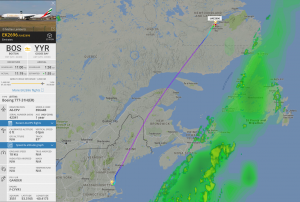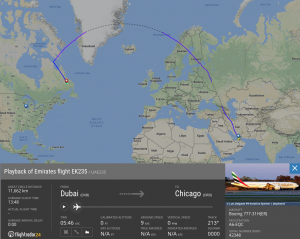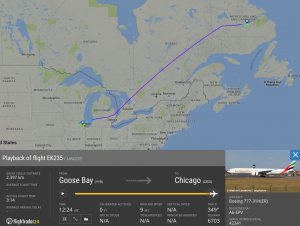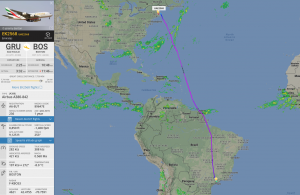On Wednesday July 18, Emirates flight EK235 from Dubai (DXB) to Chicago (ORD) diverted to Goose Bay (YYR) due to an issue with the right engine. The flight was operated by A6-EQC, a Boeing 777-300ER. The events that followed to get the passengers to Chicago involved two additional aircraft and highlighted the quick thinking of the Emirates operational team.
Flight EK235 diverted to Goose Bay at 18:30 UTC. At 03:19 UTC Emirates sent another 777-300ER, A6-EPV, from Boston (BOS) to pickup the passengers. A6-EPV was supposed to fly from Boston to Dubai as EK238 around the same time, but instead the passengers were stuck in Boston (more on them later).

By 08:57 UTC, A6-EPV had picked up the passengers from the diverted flight and was on its way to Chicago, where it landed at 12:10 UTC. The plane then picked up the passengers from last night’s EK236 Chicago to Dubai, which was originally supposed to be operated by the diverted A6-EQC, and took off at 14:54 UTC to Dubai.
Meanwhile in Brazil, there was an empty Airbus A380 on the ground because the July 18th early morning EK262 flight from Sao Paulo (GRU) to Dubai was canceled due to a technical issue and the passengers were already rebooked on other flights. This A380, A6-EUT, departed Sao Paolo at 6:30 UTC July 19 to fly to Boston and finally get the passengers of EK238 to Dubai. It landed in Boston at 15:43 UTC and its next flight will be to Dubai.
The original 777 on the Dubai to Chicago flight, A6-EQC, remains at Goose Bay at this point and no information about its status to return to service has been issued.
This situation demonstrated how one diversion can bring together two other aircraft from the fleet and the complicated logistics that get figured out whenever a diversion like this occurs.
*Click on any picture in this article to view the FlightRadar24 playback of that flight.





Facebook Comments